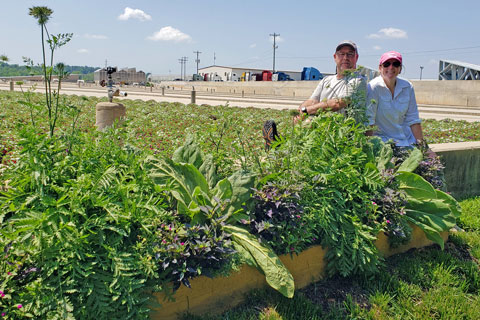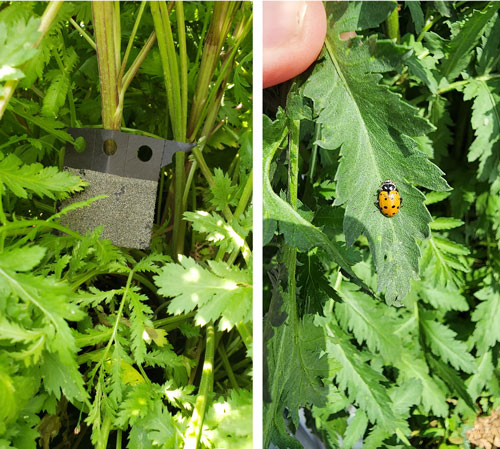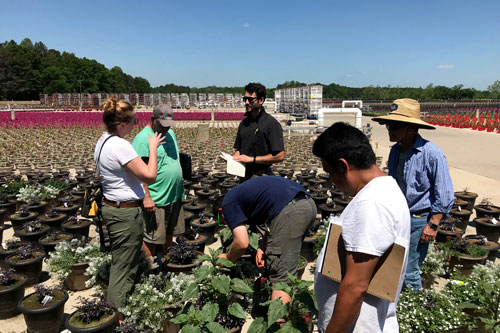11/1/2023
Using Banker Plants & Associated Beneficials
Russell Freiert & Suzanne Wainwright-Evans

Metrolina Greenhouses has made a commitment to reduce their pesticide footprint on both their workers and the environment through the use of biological control. Their journey began with the introduction of commercially produced beneficial insects and mites, and later incorporating banker plant systems. Although initially confined only to the greenhouses, Metrolina extended the use of banker plants to outdoor production areas as well. Most recently, they’ve been actively creating habitats to attract natural predators from the surrounding areas.
Pictured: Russell Freiert of Metrolina and Suzanne Wainwright-Evans of Buglady Consulting sitting next to the inground insectary plantings.
About 10 years ago, Metrolina began looking into introducing a biological control program. They started off very small, just to see the process and how hard it would be to implement in a greenhouse setting. They began with some barley banker plants to help produce Aphidius colemani (a parasitoid of smaller aphids) and some Purple Flash Peppers (a pollen source for the minute pirate bug, Orius insidious) for the control of western flower thrips. Banker plants were strategically positioned within the crop, as well as on the hanging systems. While the concept was promising in theory, they encountered challenges in maintaining optimal irrigation of the pepper plants. As a result, the program failed.
Undeterred, the head grower of the plug range, Juan Ponce, took the initiative to implement some banker plants on his outside growing area. He started with the pepper and barley plants, but also included mullein (Verbascum sp.) for Dicyphus hesperus for general pest control. Plants were still randomly placed throughout the crop in the hopes of having multiple points of distribution. This also presented a problem for optimal irrigation. The banker plants had higher watering requirements compared to the crop they were meant to safeguard. While they didn’t achieve the desired results, they recognized the significant potential of this program.
In Metrolina’s ongoing efforts to advance the biocontrol program, Russell Freiert became more involved. He was truly committed to making the beneficials work. One significant decision was to consolidate the individual banker plants into strategic groupings around the crop. The reasoning behind this change was multifaceted: it facilitated better watering management for grouped plants, provided enhanced protection for beneficials against wind and other environmental factors, and—perhaps most importantly—reduced the risk of inadvertent pesticide exposure for the banker plants. When they were dispersed throughout the crop, avoiding pesticide sprays on bankers was challenging.
 Russell and the growing team noticed that the beneficials that we were introducing were doing a pretty good job, and decided they would introduce more beneficials like green lacewings (Chrysoperla rufilabris) and some caterpillar egg parasitoids (Trichogramma sp.) to help with other pests. They set about finding plants that would be good hosts for these. They selected Queen Anne’s lace, Lobularia sp., Echinacea sp. and tansy to name a few. Their scouts noticed that sunflowers were an excellent host for the minute pirate bug and added these plants to the program.
Russell and the growing team noticed that the beneficials that we were introducing were doing a pretty good job, and decided they would introduce more beneficials like green lacewings (Chrysoperla rufilabris) and some caterpillar egg parasitoids (Trichogramma sp.) to help with other pests. They set about finding plants that would be good hosts for these. They selected Queen Anne’s lace, Lobularia sp., Echinacea sp. and tansy to name a few. Their scouts noticed that sunflowers were an excellent host for the minute pirate bug and added these plants to the program.
Pictured: Green lacewing (Chrysoperla rufilabris) eggs are seeding into the insectary plantings.
Native beneficials, like this convergent ladybird beetle (Hippodamia convergens), have shown up on their own in the Metrolina insectary plantings.
Another interesting observation was the discovery of local beneficials moving into the plants—insects like syrphid flies, ladybird beetles, damsel bugs, hunter flies and others. Because many beneficials need pollen and nectar in their diets, they were attracted in, as these plants were providing it for them.
The mass plantings were easier to manage, and made applying the beneficials easier and faster, but they were taking up valuable growing space. Also, it was a yearly expense for pots and labor to get things rolling in the spring and disposal in the fall.
The next step was to move the plantings to the ground at the perimeter of the crop. Plantings were done in raised beds in the spring once the weather broke. This had an immediate effect on watering the plants. They only needed to irrigate for about two weeks to establish a good root system necessary for the hotter weather.
Once that happened, the plants were off to the races and really only needed to be pruned at a good height so as not to fall over. The gardens were planted with multiple varieties in them and made an excellent habitat for all sorts of beneficials (both natural as well as “store-bought”). The following spring, as the perennials return, the annuals can be planted around them. Some of the plants that can tolerate a moderate winter can start growing earlier, getting a head start. Russell observed that naturally occurring beneficial insects, such as ladybird beetles and syrphid flies, appear in the gardens much earlier than commercially reared beneficials would typically be introduced. Having these beneficials available early helps stop pests from getting started in the crops.
When they knew that the program was working, Russell was able to more easily forecast sowing of plants in the spring. Using plugs instead of larger pots allows them to conserve valuable greenhouse space, especially crucial when space is in high demand. Planting of the banker/insectary plants is usually done by Russell, which doesn’t pull labor from other tasks in the greenhouse. He maintains program health through vigilant monitoring of both the banker/insectary plants and the crops. When a pesticide application becomes necessary, growers collaborate with him to choose a product that will have minimal adverse impact on both the released and native beneficial insects.
As they aimed to advance the program even further, they reconsidered the concept of cultivating banker/insectary gardens in pots where inground plantings cannot be done. Recognizing past challenges with irrigation, they devised a solution by opting for substantial plantings in large totes, reducing the need for frequent watering while maintaining the flexibility of relocating them. These totes provide homes to many local beneficials, including spiders. To understand which plants to use, they have a monitoring program where they’re tracking the beneficials found on the different plants. Currently, Metrolina has 10 varieties of plants that help make a more diverse habitat in these beneficial gardens.
 The program implemented by Metrolina over the past five years has proven to be an outstanding success. They’ve significantly reduced insecticide applications, transitioning from a weekly schedule to every other week or even every third week in areas where beneficial insects and predatory mites are employed. This reduction in the use of pesticides is a victory for the applicators, the environment and pollinators, ultimately benefiting consumers and the bottom line.
The program implemented by Metrolina over the past five years has proven to be an outstanding success. They’ve significantly reduced insecticide applications, transitioning from a weekly schedule to every other week or even every third week in areas where beneficial insects and predatory mites are employed. This reduction in the use of pesticides is a victory for the applicators, the environment and pollinators, ultimately benefiting consumers and the bottom line.
Pictured: Suzanne Wainwright-Evans of Buglady Consulting working with the Metrolina team, teaching them how to identify beneficials.
Everyone has liked the program so much that they’re looking for new ways and areas to implement the program. It’ll take some time to get some of the kinks out because every area is going to be slightly different. Different crops mean different pests. The growers are enthusiastic about expanding their beneficial insect programs and reducing their dependency on chemical pest control. Additionally, they’re revisiting the idea of an indoor program within the greenhouse, though they’re encountering the same old problems with keeping the banker plants properly irrigated. The totes are too large for indoor use, but streamlining the plant species they use indoors with larger pots may solve this issue.
Metrolina has invested significant time and effort into this program, recognizing the dedication needed to establish a successful biological control program. While they encountered some challenges along the way, instead of giving up, they’ve been actively finding solutions to make it succeed. Their aspiration is to substantially reduce their reliance on insecticides in the coming years and the growers are confident that they’re making substantial progress toward achieving this goal. GT
Russell Freiert is the IPM Specialist and in Purchasing at Metrolina Greenhouses, where he’s been for 23 years. Suzanne Wainwright-Evans is the owner of Buglady Consulting, providing pest management consulting services to the industry for over two decades.